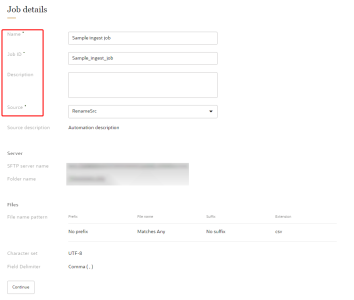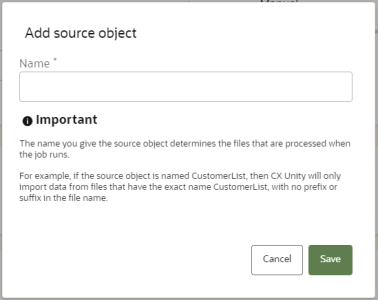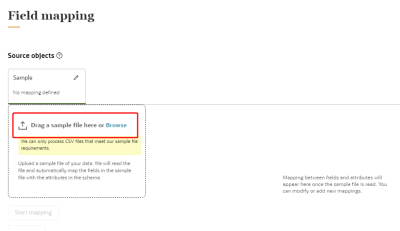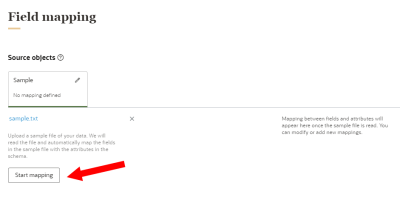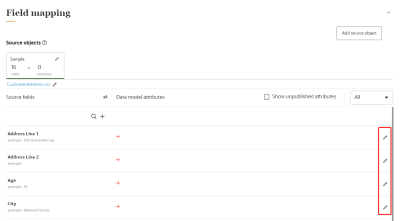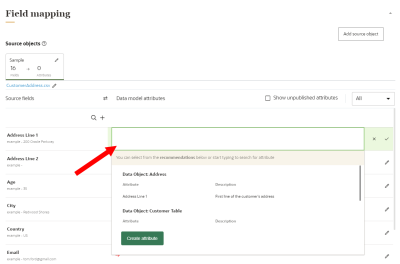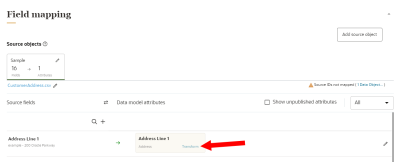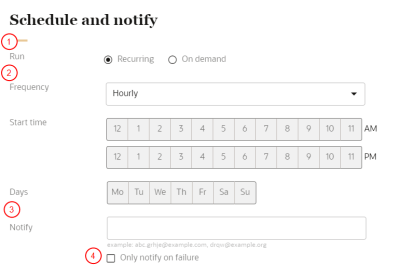Setting up the import of email address data
To set up the import of email data and configure it for export to Oracle DMP, you will need to do the following:
-
If required, create a source to configure the source of data that Oracle Unity will use to import email address data. Otherwise, use the existing source to import email address data.
-
Update the existing ingest job that imports email address data. Otherwise, create a new ingest job to import email address data.
-
Configure the field mapping of the ingest job to map the HashedEmail attribute created previously to the source field that stores email address data.
-
Apply the Hash transformation to HashedEmail > Email mapping so that the data is imported in the proper format and can be exported to Oracle DMP.
-
Note: This integration is currently under controlled availability. To learn more about enabling this feature, contact Oracle Support.
Learn more about correctly formatting source files and ingest jobs so that you can successfully import data:
-
Ensure source files are formatted correctly by reviewing CSV file standards for Oracle Unity and supported CSV parsers.
-
Review how to import empty or null data and the restrictions on empty/null data in the Oracle Unity data model.
Create the source
If you don't have an existing source configured to import email address data, follow the steps for Creating sources and select the source type Secure FTP. You will then select this source to configure the ingest job.
Update ingest job to import email address data in proper format
If there is an existing ingest job to import email address data, follow the steps for Managing ingest jobs and update the field mapping with the following configurations.
-
Map the new HashedEmail attribute to the source field that stores email address data.
-
Apply the Hash transformation with the following parameters.
-
Select SHA-256.
-
Make sure that the checkbox for Convert to lowercase is checked.
-
If there isn't an existing ingest job to import email address data, follow the steps below to create a new ingest job with the required configurations to map the HashedEmail attribute and apply the Hash transformation.
Creating an ingest job
If there isn't an existing ingest job to import email address data, follow the steps below to create a new ingest job with the required configurations to map the HashedEmail attribute and apply the Hash transformation.
To create the ingest job:
-
Click the Oracle icon
 in the bottom-right corner to open the navigation menu.
in the bottom-right corner to open the navigation menu.
- Select Data feeds.
- In the top-right corner, click Create data feed, then select Ingest job.
The Create ingest job page is displayed.
Step 1: Define job details
The job details section allows you to define how the ingest job will display in Oracle Unity. You will also need to select the source you previously created.
To define the job details:
- Enter the details for the ingest job.
- Name: Enter a name. The name must be 1 or more characters, up to a maximum of 50. Use only letters (a–z and A–Z), numbers (0–9), underscores (_), hyphens (-), and spaces. The first character cannot be a space.
-
Job ID: The unique system identifier that is auto-populated from the job name you enter. You can't change this value after you create the job.
- Description: Enter a description. This field is optional, but it is highly recommended to add descriptions for any entity created. This helps all other users get additional context when using and navigating Oracle Unity. The description can have a maximum of 512 characters with no restrictions on characters used. You can use characters from all languages supported in the language settings.
- Source: Use the drop-down list to select the source you previously created. The details of the source will display. Review the details and make sure they are accurate.
- Once you have confirmed that the details are correctly configured, click Continue.
Step 2: Field mapping
You will have to set up manual field mapping to configure how the data will be imported into Oracle Unity. Field mapping allows you to define how fields from your source files are mapped to the attributes in the data model.
To set up manual field mapping, you will need to do the following:
- Create a source object
- Add a sample file of the source fields
- Review the configurations and make changes as needed.
- Define how the data that is ingested into Oracle Unity will be formatted.
Create a source object
To create a source object:
- Under Manual, click Create source object.
-
Enter a name for the source object. The name must be 1 or more characters, up to a maximum of 50. Use only letters (a–z and A–Z), numbers (0–9), underscores (_), hyphens (-), and spaces. The first character must be a letter.
Important: The name you give the source object will determine the files that are processed when the job runs. For example, to import address data, make sure to include "address" in the source object name so that all files with "address" in the file name will be identified for import. If you select an Automatic file name pattern when configuring the source, Oracle Unity will use the source object name to create the file name pattern. Oracle Unity will include compressed files as well as files with a prefix or suffix when matching and importing files. Please be aware that the source object name you define is case sensitive.
If needed, you can edit or delete the source object. If you delete a source object, all field mappings configured for the source object will be deleted as well.
To edit or delete the source object:
Add a sample file of the source fields
To complete manual field mapping, prepare a sample file that meets the following requirements:
- The sample file is in CSV or TXT format.
- The delimiter defined in the custom regular expression for the source file matches the delimiter in the sample file.
- The sample file is less than 100MB.
To add a sample file:
- Drag the sample file to the sample file section or click Browse and select the file on your computer. You have the option of adding sample values to the fields.
- Click Start mapping.
- Follow the steps below to start mapping source object fields to data model attributes.
Mapping source object fields to data model attributes
Note: You cannot access or search for hidden data objects and attributes for field mapping. Learn more about Hidden data model items in ingest jobs.
To map source object fields to data model attributes:
- For the source field that stores email data, click Edit
 .
. - Select or search for the email attribute created previously.
- To add the attribute, click the Checkmark
 .
. - Add a transformation to the attribute by clicking Transform.
- Select a Hash transformation.
- Make the following configurations for the hash transformation.
- Select SHA-256.
- Make sure that the checkbox for Convert to lowercase is checked.
- Continue following the steps for configuring additional field mappings and managing source fields.
Step 3: Schedule and notify
You will need to configure the schedule and notification settings for the ingest job.
To schedule the ingest job and define the notification settings:
- Configure the schedule for the ingest job:
- Click Recurring to automatically run the job on a regular schedule. If a job is still running while the next one is scheduled to run, the next scheduled run will not start until the current one completes. Two scheduled instances of the same ingest job can't run simultaneously.
- Click On demand to run the job as needed.
- If the job is recurring, select the Frequency, Start time, and Days it will run.
- In the field for Notify, enter the email addresses of people to be notified when the job runs. Separate multiple emails with a comma.
- If you only want a notification if the job fails, click the checkbox for Only notify on failure.
Please note that the metrics for ingest jobs in notification emails are approximations and will not always be 100% accurate.
Step 4: Save and publish the ingest job
After saving the ingest job you will need to publish the changes before it can run.
To save and publish the ingest job:
- Scroll to the top of the page and click Save or Save and close.
- Follow the steps for Publishing changes.
When the publishing task is completed, the ingest job can run. Learn more about Managing ingest jobs.
After importing email data in the proper format in the Oracle Unity data model, you can follow the steps for Exporting Oracle Unity segments to Oracle DMP.
